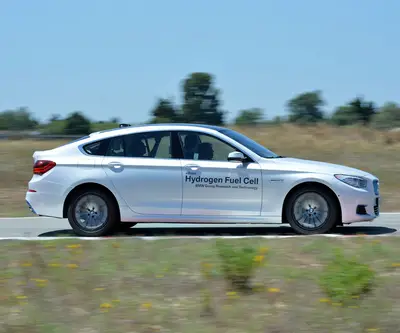BMW Tests Fuel Cell Technology In 5 Series GT Prototype by Henny Hemmes +VIDEO
By Henny Hemmes
Senior European Editor
This year, BMW used its Innovation Day at the Miramas test track in France to present us with its latest innovations. This time I will review the third technology that we saw that day: the fuel cell system in the BMW 5 Series GT prototype.
Earlier we already highlighted its plug-in hybrid system and drove the 2 Series Active Tourer PHEV prototype. We also drove a 1 Series proto with a turbo engine with direct water injection. All technologies are part of BMW’s Efficient Dynamics, technologies that have been developed or are under development in the quest for alternatives to fossil fuels.
One such solution is the use of hydrogen, but the lack of possibilities to transport and store it, are the reason why we are talking about a mid to long term possibility. In the meantime, quite a few car manufacturers are looking into fuel cell technology.
Early start
I do remember quite well my first test drive in 2006 with a BMW Hydrogen
7 Series. It was BMW’s third research project for the use of
hydrogen. The mighty 6-liter V12 engine had been adapted to run also on
hydrogen. To this end, a special tank was placed in the luggage
compartment. It could store nearly 18 pounds of liquid hydrogen under the
required temperature of -235 degrees.
But the 2006 test wasn't BMW's first go-around with using hydrogen as a fuel. BMW began working with hydrogen concepts about 30 years ago. BMW had started to develop its first car that could use hydrogen and presented the 750hL in 2000. It was followed in 2004 by the H2R, the Hydrogen Record Car, a racing car that ran on liquid hydrogen and reached a top speed of 186.5 mph, establishing an international world record at the track in Miramas. Unfortunately many problems plagued the efforts, such as cooling and evaporation of the hydrogen during storage. In the meantime, BMW had also started to focus its research on electric power trains for what later proved to be the i3 and PHEV i8.
Joint development with Toyota
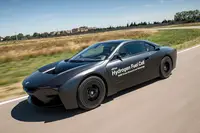 |
At the Miramas proving ground, BMW showed us two FCEV, fuel cell electric vehicles: the ‘eDrive Hydrogen Fuel Cell prototype’ and the 5 Series GT. The first is built on the construction of one of the first prototypes of the i8.
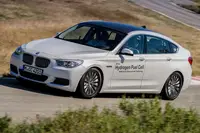 BMW 5 Series GT Prototype |
In 2003, Dr. Klaus Fröhlich, BMW Group’s board member for development, witnessed the signing of the contract by Dr. Norbert Reithofer, then BMW/s CEO and Toyota’s President Akio Toyoda. At Miramas he said that fuel cell technology is a fixed value of the Efficient Dynamics strategy for the future. “A fuel cell car is refilled in 5 minutes and then you can drive more than 300 miles. Charging the battery of the EV takes much longer and the range is much shorter.”
BMW patented tank and refueling system
During the Innovation Day, we were shown the different components of the
fuel cell system. Matthias Klietz, head of power train research said
“The fuel cell stack is delivering 90 kW/120 hp and has been
developed by Toyota." It is already used in the Mirai, “however, we
built a different housing.”
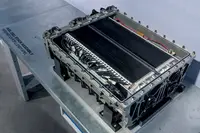 BMW 5 Series GT Prototype |
BMW and Toyota jointly developed the auxiliary, but the 180 kW/245 hp electric motor is a variant of the unit used in the BMW i3, while power electronics, the intelligent energy management and the 1 kWh high-voltage battery are based on BMW’s eDrive technology. BMW also developed the 1 kW high voltage battery and the so-called cryogenic pressure storage tank as well as the refueling system. Both have been patented by BMW. On display was also the 6.5 feet long, double-wall cylindrical tank, which is mounted underneath in longitudinal direction as a tunnel tank between the front and rear axle, the place where you normally find the prop shaft. Currently, the industry standard is a technology, which stores 4.5 kg (10 lbs) of hydrogen under a pressure of 700 bar (CGH2).
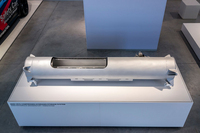 BMW 5 Series GT Prototype |
It is also possible to store so-called ‘cryo-compressed’ (or cooled) hydrogen, a technology developed by BMW. In this case gaseous hydrogen can be stored at low temperature at a pressure of up to 350 bar. In this case, 7.1 kg (15.6 lbs). These types of storage provide a driving range of more than 500 km/300 miles. BMW is testing both ‘vessel’-technologies.
Mr. Klietz said that the fuel cell system weighs 350 pounds, or some 220 pounds more than the 5 Series GT with combustion engine. “However, there is potential for weight saving in all components. The tank is still a problem, just like the electric components.”
 BMW 5 Series GT Prototype |
Short spin
We were permitted a spin of a couple of laps with the 5 Series GT
prototype on the test track in different modes. Like an electric car, there
is no noise when you push the start button, but at around 4 mph you can
hear a whirring sound that is generated by the fuel cell system when it
starts feeding the electric engine. . “This is an
early development car and one of the things we have to address is the
noise and sound dampening,” said Klietz.
The car feels faster than I would have expected with 245 hp, but this is because torque of the electric drive is immediately available. BMW mentions an acceleration time for 0-62 mph of 8.4 seconds and a top speed of 110 mph. The prototype also feels more solid. Not surprisingly so because of the higher weight, but also thanks to integrating the tank in the car’s structure.
 BMW 5 Series GT Prototype |
Challenges
Mr. Klietz said to expect that fuel cell cars will have a good presence
by around 2025 to 2030: “ But there are challenges that have to be
addressed, like cost and building all the hydrogen stations.”
Today, Germany has 50 stations and plans to have 400 by 2023. In southern California there are a dozen stations and around twenty in the planning. There are 3 stations in the Bay area with 14 more planned. Canada has one, Japan 26, South Korea 10, Taiwan 2, India 1, and China has 1 in Beijing with others planned for Shanghai and Zhengzhou. This is not many, but I remember a similar situation with the charging stations for electric vehicles. While it's a slow process, we'll finally get there!



